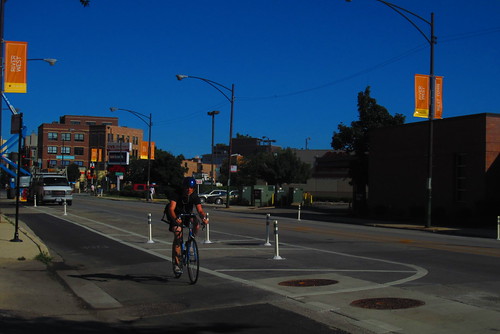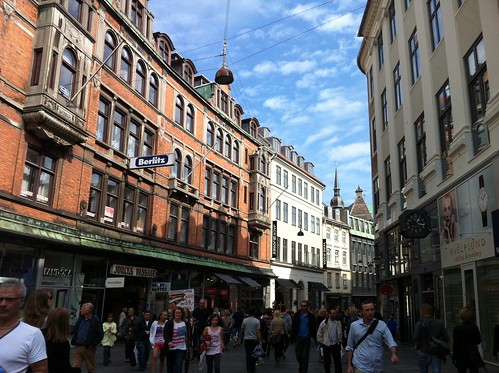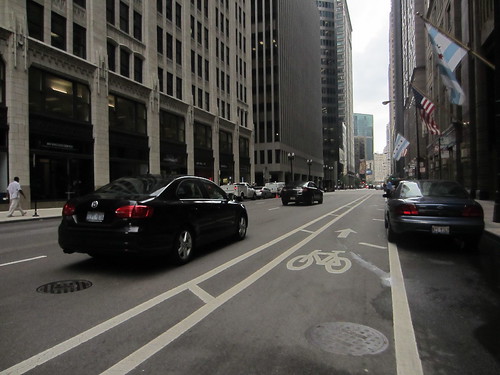[This is the first post of a two-part series by guest contributor Kristen Maddox. Kristen recently spent a year in Denmark as a Fulbright fellow and worked with Copenhagenize Design Company. Now back in the US, she is actively looking for work in bicycle planning and advocacy. We'll post the second half this piece on Wednesday.]
At first glance, comparing a city to Copenhagen -- especially an American city -- runs the risk of being an apples-to-oranges affair. The portion of history that most traffic planners focus on when they look to Copenhagen begins in the mid-1900s, usually in the post-war period. Since there are already so many good examples of articles and books covering Copenhagen’s development, I’d like to home in on the most recent infrastructure developments.
Where is Copenhagen now, and how does it compare to Chicago’s current and future plans? Bicycle mode share in Copenhagen is 36 percent, according to the city's 2012 Bicycle Account, released this year. Chicago’s current level is 1.3 percent. Chicago’s current goal is 5 percent mode share by 2020 versus Copenhagen’s goal of 50 percent by 2015. Copenhagen has almost too many bicycle facilities to mention: bike superhighways, “green wave” bike-friendly signal timing, bike bridges, bicycle counters, and more.
Let’s take Chicago’s new modal hierarchy as a jumping-off point to introduce the Windy City’s current traffic plans. Part I of this article compares the bicycle culture, planning culture, and ‘typical’ bicycle infrastructure of each city.
If you’re short on time, here’s my main point: If Chicago is to come into its own as a safe place to ride a bicycle, as well as a "best practices" example for other cities, it needs to strut its stuff. Bikeway planning should not remain static and repeat the design flaws that are already in place on some Chicago streets, but view existing assets as valuable products worthy of the world stage, able to push the envelope of what’s considered possible.
Pedaling through newer road designs such as Milwaukee Avenue, Dearborn Street, or 31st Street, one sees that Chicago has the necessary ingredients for safe and comfortable bicycle use. But these elements do not yet form the complete whole necessary to encourage bicycle use by the so called “interested but concerned” riders, even as the overall number of bicyclists does increase. Let’s compare the different aspects of cycling in Chicago and Copenhagen to see what’s needed to encourage more risk averse people to ride here.
Bicycle culture
Suffice to say that Chicago and Copenhagen have drastically different bicycle cultures. For example, let’s look at the urban planners who promote cycling in these cities. In Copenhagen, there’s an almost plodding, matter-of-fact rhythm to this work. Planners know that even in the new districts, cycle track will be a given. There is less squabbling over minutia and diversion over technical terms because everyone is familiar and comfortable with bike infrastructure. In the grand scheme of things, I think there is much more trust from advocates in the traffic department’s ability to “get it right,” because bike planning has been done well for decades. Of course there is critique, plenty of it, just like in Chicago, but it appears that there is more disagreement over which large-scale plans to execute than over tiny details.
As Chicago adds more protected and buffered bike lanes, design details will determine how the entire bike transportation network functions. Chicago’s newest bicycle facilities show a diversity of layouts. Whereas Copenhagen has four types of bicycle lanes and paths, Chicago already has a greater variety of bikeways. The relationship between the bike lane and car parking, the width of the bike lane, the level of protection, and the pavement markings can vary from one block to another. This suggests that Chicago bike planners are using trial and error, while in Copenhagen the system is more standardized.
Modal Hierarchy
Next let’s compare how different transportation modes are prioritized in the two cities. The Chicago Department of Transportation’s recently released Complete Streets Chicago guide establishes a new modal hierarchy, which the Richard M. Daley administration began to explore, but which has been made more explicit and concrete in this latest plan. The document calls for the reprioritization of road user types, valuing the interest interests of pedestrians over all other modes, followed by transit, bicycles, and cars.
Copenhagen claims the Strøget, a pedestrianized street in the medieval city center, is the world’s oldest and longest car-free street at 3.2 km, about 2 miles. Here in the core, walking is an efficient and enjoyable mode. It’s like a year-round version of Open Streets on State Street. Emphasis is placed on invitations to mingle in the public realm, not unlike the original “agora”. Other smaller pedestrian-only streets and squares create havens away from motorized traffic—elements that are largely missing in present-day Chicago.
Bicycle infrastructure design
Copenhagen is an established "city for cyclists." Whereas CDOT is increasing the number of streets with bicycle facilities, every road in Copenhagen is a cycling street. If there is no bicycle infrastructure, the speed limit for cars is 30 kilometers-per-hour (19 mph) or less.
These low-speed streets are some of the most inviting roads for walking. They are often lined with cafes and bars with sidewalk seating, boutiques, kiosks, and other pedestrian-oriented businesses. The street becomes a place to linger, not just a place to travel through.
In Chicago, most streets don’t have bike facilities. These range from low-speed, quiet neighborhood streets suitable for cycling, to oversize speedways like Congress Parkway. Despite the recent removal of a travel lane on some blocks and the addition of pedestrian refuge island, Congress is still not attractive for cycling.
The Streets for Cycling Plan 2020 groups Chicago's planned bike routes into three categories: Neighborhood Routes, Crosstown Routes, and Spoke Routes. Of the four different bikeway design types -- protected bike lanes, buffered bike lanes, traditional bike lanes, and marked shared routes -- protected lanes are preferred on Crosstown Routes and Spoke Routes, while bike boulevard treatments are preferred for Neighborhood Routes.
Riding Chicago’s protected and buffered lanes, one sees that the design type is actually quite varied. In Copenhagen, cycle tracks are always located to the right of parked cars. In contrast, many of Chicago’s so-called protected lanes include sections where the bike lane is located in the “door zone” to the left of the parking lane. On the new stretch of protected lanes on Milwaukee Avenue between Kinzie Street and Elston Avenue, for example, the bicycle lane’s location alternates between the left and right sides of parked cars.
Chicago street surfaces also lack uniformity. I recently counted 107 manhole covers along the two-way protected bike lanes on Dearborn Street between Polk Street and Kinzie. Even with new striping, lane painting, and political support, old potholes remain. Like jousting with car traffic, this is something Copenhagen cyclists do not need to make an effort to avoid; they rarely exist.
In Copenhagen, conflicts between bicyclists and motorists are unusual. Even on the massive HC Andersen Boulevard, similar to Michigan Ave, cyclists are protected from cars on cycle track. Chicagoans who visit Copenhagen experience massive culture shock when they discover that everyone from pedestrians to sports car drivers to truckers yields to cyclists. That never gets old.








